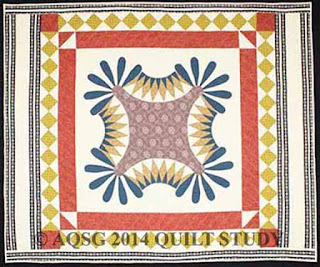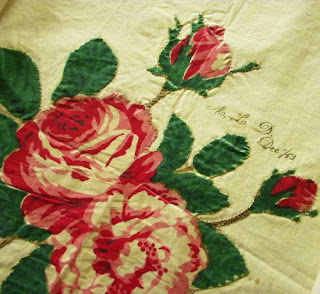Reproduction block by Becky Brown,
a white chintz contrasting with a blotch-ground chintz for the background.
Notice the white lines around the florals in the background.
These signs of poor print registration are often referred to as halos.
Early-19th-century British quilt with
a blotch-ground red chintz next to a classic Polka dot
My collection of vintage blotch ground chintzes from America's Printed Fabrics
Chintzes have been so popular that there are many styles within the category. Last week I showed white-ground chintzes.
Vintage quilt detail, early 19th-century
White-ground chintzes were the rage in the 18th-century but towards 1800 taste changed.
Dark-ground chintzes became a fashion item for quilts and clothing
Vintage wholecloth quilt of a dark-ground pheasant print
Brown chintz dress, an 18th-century round gown, from Historic Deerfield
Note the blue check in the sleeve lining.
See a post on dark-ground chintz fashion by Hallie Larkin here:
Printers had several methods for creating the dark ground chintzes. Madder printing with different mordants was one way to do it.
Vintage madder-printed pheasant and palm tree print
The registration is good, which means the
figures fit nicely into the background with
few gaps or overlap. That's one of the advantages to madder dyes.
Reproduction star by Bettina Havig
But if you wanted lots of color in the chintzes (and who didn't?) you could change a white-ground chintz to a dark ground chintz just by adding background color. The printers used block technology to add the backgrounds. I've seen references to a wood block with a felt shape glued onto it that was called a blotch.
Melbourne, Australia, newspaper ad for
drab ground, white ground and blotch ground chintzes in 1855.
"Drab" ground refers to quercitron-dyed prints, which
we'll discuss in July.
Blotch now has several meanings, most commonly an irregular shape. Printers use the word differently now too but in the past blotch as a textile term meant an added background color.
Dyers could add any color they could print with the blotch technology so you often see the same chintz with different backgrounds, what we call different colorways.
Added tan grounds were often called tea ground.
Registration in blotch-ground prints was poor, an obvious flaw that no one seemed to mind.
The blotch block left huge halos around the flowers and leaves.
Tea-ground blotch chintzes are often found in early quilts
Detail of a tea-ground chintz star from the
Boston Museum of Fine Arts
Added red ground was another option
More overlap than halos in this red version of
the pheasant and palm tree print.
Vintage red chintz, technically sub-par.
There's too much going on here for our taste.
A reproduction would NEVER sell.
Medium blue grounds were fashionable in the early 19th century.
(And look good today too.)
The glaze is still on this vintage piece.
You could even buy an outrageous shade of yellow
Reproductions
Becky looked through her stash for registration errors to give the traditional
blotch-ground chintz look.
2 Stars by Becky
She'd had this piece of glazed purple chintz for years.
Here a little hint of halo in the blue.
Reproduction star by Bettina Havig
Sometimes you have to compromise and just go
for a well-registered colored ground. It's the color and the fabric's
figures and scale that are most important.
A red ground chintz with lovely geranium leaves
from the panel for Kathy Hall's Southcott quilt.
The print is in the corners of the original dated 1808
in the collection of the Royal Albert Museum.
A similar geranium with a red ground in a vintage quilt from the collection of Old Sturbridge Village
A repro tea-ground by Pat Nickols
Again, a hint of halo
Chintz florals fit nicely into their backgrounds today with perfect registration due to contemporary technology. What you are looking for is multi-color florals deliberately printed with gaps and halos.
Savannah by Fons and Porter
I'm hoping you have some of these old reproduction prints in your scraps.The imitation blotch-ground prints are hard to find because there is little cross-over market for them. You must appreciate the look to want to buy a badly registered print.
Jo Morton's Bird Chintz
You may not care for the print as a whole but you'll find that a few
scraps patched into a block gives an authentic early look.
Early Stars, reproduction by Barbara Schaffer
Here's a beautiful reproduction from Nancy Gere she
calls Valley Forge. Just enough halo and tinted tan
to make it a cross-over print, rather than just for repro lovers.
Sawtooth Strip by Barbara Brackman
I found the brown ground chintz for the alternate strips in this reproduction of the 1840s look at a home decorating store. I bought the bolt on sale. They were glad to see it go.
What to Do with Your Stack of Stars?
Alternate with broderie Perse blocks.
Block dated 1853
Broderie Perse is also called Cut-Out Chintz applique.
I couldn't find any photos of period star quilts alternating with chintz cut out floras.
But isn't it a good idea? I did a digital mockup. For 6" finished alternate blocks your cut-out-chintz applique will have to be fairly simple.
Above and below: two simple cut-out chintz motifs
from about 1800-1840.
Antique red ground chintz with halos
The old chintz with its bad registration was perfect for broderie Perse.
The halos meant you could applique a red chintz or a tan chintz to a white background and the tan wouldn't show.
Vintage broderie Perse
A heavy buttonhole stitch also hid the colored botch grounds.
One More Thing About Blotch-Ground Prints
Vintage hat box covered in the tea-ground version of
the pheasant and palm tree
The date on these imported blotch-ground chintzes in the United States seems to be about 1820-1840.
Chintz medallion quilt
Gift of Sandra Dallas to the Rocky Mountain Quilt Museum
Details show the variety of blotch-ground chintzes.
They were available in abundance when international trade opened up after the end of the Napoleonic Wars in 1815. We find so many surviving examples that textile historians guess they are among the British prints "dumped" after the war. Americans tended to blame the British for undermining the domestic printing industry with shiploads of prints, but Britain may have been glad to get rid of them because they'd been designed for the American market. You just don't see the abundance of them in English quilts that you do in American.
Although this detail of the very English Jane Austen quilt
at Chawton shows scraps that look to
be cut from brown, tea, and blue-ground chintzes.













































QCGk~%24(KGrHqMH-DEEreEq4qeoBK7%2CSdVzQQ~~_3.jpg)












































